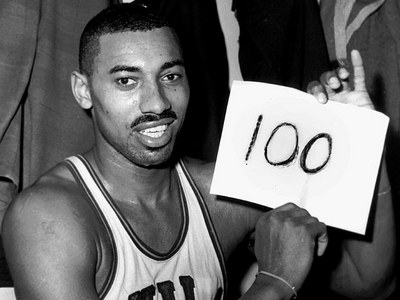Which Wilt?
By Dr. Daniel Durbin | 3/2/12 |
Today marks the fiftieth anniversary of one of American sport’s sacred numbers. Fifty years ago today, Wilt Chamberlain scored 100 points in a single NBA game, while playing for the then Philadelphia Warriors. Chamberlain’s 100 point game was a signature moment in American sports . . . if not in American sports media. And therein rests the story.
We often forget what a dominant physical presence Wilt Chamberlain was on a basketball court. Towering over other players, Chamberlain seemed to set nearly every scoring and rebounding record of his day.
During the 1961-1962 NBA season, he averaged an almost absurd 50.4 points per game, a number no NBA single-season points leader has come close to matching. The following season he slipped to a paltry 44.8 points per game.
Chamberlain was the first player to score over 30,000 points. He still holds the record for most career rebounds. In an age of athletic specialization, we often think of rebounds and scoring as separate categories. Chamberlain dominated both.
With our twenty-four hour sports news cycle on ESPN, our local and national games on Fox Sports, and the perpetual din of highlights and lowlights from each day’s sports flooding our local news broadcasts, national sports broadcasts and youtube, it seems hard to believe that the greatest achievement in a single NBA game was not even shown on television.
In a world in which even a mediocre 5-4-3 double play warrants 3-4 replays and even more highlight showings overnight on ESPN, Chamberlain’s greatest moment exists only in stories told second hand. Like the Babe’s “called shot,” Wilt Chamberlain’s 100 point game lives on by word-of-mouth, stories told by those who never had a chance to see it.
And, Wilt “The Stilt” Chamberlain, the force that could not be denied, fades deeper and deeper into our collective memory. His greatness as a basketball force dimmed behind old black and white photos; his dominance lost in the whirlwind of highlights of Magic and Isaiah and Michael and Kobe and Shaq and LeBron.

If greatness is measured in championships, Wilt was not even the greatest player of his own era. Surely Bill Russell was that. If greatness is measured in pure physical dominance, it is nearly impossible to think of another player who can come close to measuring up to the Wilt Chamberlain who towered fifty years ago.
Yet, who is Wilt Chamberlain today? On the fiftieth anniversary of his greatest athletic achievement, ESPN spent nearly half their report on this golden anniversary discussing the number 20,000, rather than the number 100.
Years after retirement, Wilt Chamberlain, whose career was made up of seemingly ridiculous statistics, offered an equally ridiculous and offensive statistic. In his autobiography, he claimed to have engaged in sex with 20,000 women.
Was this number accurate? It didn’t really matter. What mattered was that Chamberlain had made this perhaps outlandish claim in a media world in which it would immediately become unending fodder for late night talk shows, early morning radio sports talk, and the ceaseless reportage of all that is (and is not) news in the world of sports on a variety of media platforms.
Wilt’s 100 had been reported on sports reports at the end of local news broadcasts in 1962. Thirty years later, 20,000 became the Chamberlain talking point across a wide variety of media. 20,000 became the punch-line to a seemingly endless stream of jokes. 20,000 became the Chamberlain brand for a generation of sports fans and non-fans who had never seen him play.
The most dominant physical force of his era, the player with near mythic NBA numbers, became even more well-known for a number that had nothing to do with basketball. And, because a new generation of media became saturated with the Wilt Chamberlain of 20,000, the Wilt of 100, 50.4, and 31,419 slipped silently behind that new Wilt of 20,000.
ESPN reported on the 20,000 because, today, that is the number most readily associated with Wilt Chamberlain by the vast majority of the public. ESPN simply reported the news.
In 2012, professional and amateur athletes face a barrage of media platforms that dwarf those that existed when Chamberlain wrote his autobiography (not to mention, when he played). They may hope to be remembered for the numbers they create on the field or court. Wilt “20,000” Chamberlain reminds us that they can create other numbers, numbers that may replace their competitive numbers in the public mind.
Who was Wilt Chamberlain? What will be Chamberlain’s legacy?
Which Wilt? The numbers tell the story.

COMMENTS